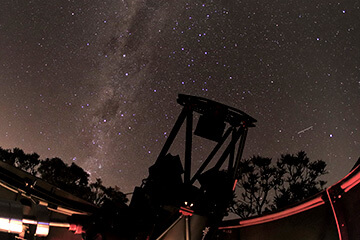Falcon Telescope Network-Outreach
Increasing student interest, engagement, and retention in science, technology, engineering, and mathematics (STEM) fields is a problem that needs to be addressed in creative ways. By providing students with opportunities to participate in meaningful, hands-on, authentic science experiences, we can hopefully spark and retain student interest in science through a variety of projects and initiatives utilizing the unique resources available within the Falcon Telescope Network.
The Falcon Telescope Network (FTN) is a global network of 20-inch telescopes being developed by the U.S. Air Force Academy Department of Physics. A fraction of FTN’s observing time is dedicated to STEM outreach, giving K-12 schools and universities the opportunity to use FTN as a tool to enhance their astronomy and science curriculum. In addition, outreach events will occasionally occur to involve the communities around each FTN node (observatory location).
First Light Project Introduction
 The kickoff STEM outreach project for FTN will be the First Light Project. First light for a telescope marks the first official images taken by a newly-commissioned telescope. It is generally a very exciting event, akin to a ribbon-cutting ceremony for a new business or a maiden voyage of a ship. Each node of FTN will have it’s own first light event, but the earliest first light of the network will be in La Junta, Colorado at Otero Junior College (stay tuned to the website for more information).
The kickoff STEM outreach project for FTN will be the First Light Project. First light for a telescope marks the first official images taken by a newly-commissioned telescope. It is generally a very exciting event, akin to a ribbon-cutting ceremony for a new business or a maiden voyage of a ship. Each node of FTN will have it’s own first light event, but the earliest first light of the network will be in La Junta, Colorado at Otero Junior College (stay tuned to the website for more information).
We would like your students to participate in an exciting First Light Project where students become scientists and a crucial part of selecting the FTN telescopes’ first images! Classes or school associated groups will submit proposals expressing which astronomical objects to image on these milestone evenings. Proposing will require initial research by the students on what objects are visible in the night sky at the particular node location and current time of year. It will also require students to try their hand at scientific writing as they communicate their proposal idea to others. The proposals will be submitted to USAFA and must include information such as the celestial coordinates of the object, background information on the chosen object, and why it should be one of the first images of the telescope. A class or group may participate in one or many of the first light events in the coming months.
Once all of the proposals are received, the FTN education team will trade them to other participating schools/classes around the country for peer review. The students will review a proposal based on a provided rubric and determine an “accept” or “reject” status. This process will provide students with an authentic research experience, as peer review is an important part of scientific practice. To encourage a variety of participating ages, appropriate grade level considerations will be implemented.
Each school with a participating class or group will receive a representative large format FTN image to hang up in their school. The other images from the evening’s event will be made available via a webpage for further investigation.
Kickoff Materials
A packet of materials will be sent to each participating teacher/supervisor. Each packet will include:
- General FTN Information
- Including how to continue involvement in the future
- Instructional Information
- Astronomy Resources
- Information about telescopes and the night sky to help your students get started
- Submission Instructions
- Specific Project Guidelines
- Proposal Template
- Schedule
- A list of science standards supported by the First Light Project
- Promotional Materials